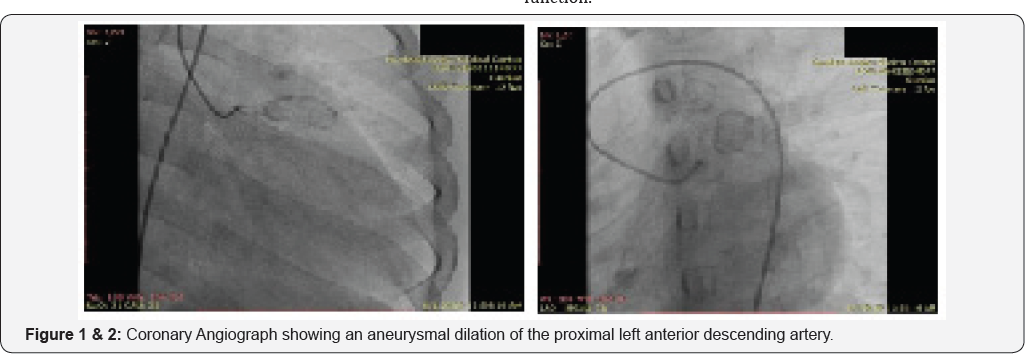Super-Giant Coronary Aneurysm Secondary to Atypical Kawasaki Disease in an 11-Year Old
Mariko Jennifer L Yamanaka*
Cardinal Santos Medical Center, Philippines
Submission: August 21, 2017; Published: August 29, 2017
*Corresponding author: Mariko Jennifer L Yamanaka, Cardinal Santos Medical Center, San Juan City, Metro Manila, Philippines, Email: mariko.yamanaka@gmail.com
How to cite this article: Mariko J L Y. Super-Giant Coronary Aneurysm Secondary to Atypical Kawasaki Disease in an 11-Year Old. J Cardiol & Cardiovasc Ther 2017; 7(3): 555713. DOI: 10.19080/JOCCT.2017.06.555713
Abstract
Background: Kawasaki Disease is an acute febrile illness of early childhood. It is seen worldwide with the highest incidence occurring in Asian children under 5 years of age and in the male gender. Major sequelae involve the coronary arterial system, leading to aneurysms and occlusions.
Case: This is a case of an 11-year-old male, who was diagnosed with Atypical Kawasaki Disease in 2007, for which Gamma Globulin and Aspirin were given. Diagnostic imaging showed severe three-vessel coronary artery disease with chronic total occlusion of the right coronary and left mid-circumflex artery and an aneurysmal dilation of the proximal left anterior descending artery measuring 12.4x11.3x25.5mm. He is the first paediatric patient in the Philippines who underwent quadruple coronary bypass and grafting.
Conclusion: This case features the significance of early diagnosis and treatment of Kawasaki Disease and regular cardiologic follow-up, taking into consideration the potential late complications of this pediatric disease.
Keywords: Kawasaki disease; Coronary aneurysm; Quadruple coronary artery bypass and grafting; Pediatrics
Case
This is a case of an 11-year-old male, who was diagnosed with Atypical Kawasaki Disease in 2007, for which Gamma Globulin and Aspirin were given. Coronary angiograph Figure 1 & 2 showed severe three-vessel coronary artery disease with chronic total occlusion of the right coronary and left mid-circumflex artery and an aneurysmal dilation of the proximal left anterior descending artery measuring 12.4x11.3x25.5mm, while the Myocardial Perfusion Imaging Figure 3 showed a moderate inducible myocardial ischemia in the mid-ventricular to basal inferior and infero-lateral segments, with preserved left ventricular systolic function.


He is the first paediatric patient in the Philippines who underwent quadruple coronary bypass and grafting. The degree of stenosis was as follows: left anterior descending artery- 100%; diagonal artery of the left anterior descending artery- 90%; obtuse marginal of the left circumflex artery- 100%; right coronary artery- 100%. The respective vessels were used for grafting: bilateral internal mammary arteries and saphenous veins. No intra- and post-operative complications were reported. To date, the patient has remained asymptomatic and has been undergoing cardiac rehabilitation.
Discussion
KD is a generalized systemic vasculitis commonly involving the coronary arteries [1]. Dilatation occurs during the sub-acute phase, generally peaking 4 weeks post-onset of illness and is diagnosed by echocardiogram [2]. Identified aneurysms are classified by size; a super-giant is greater than 10mm [1,3]. 7-20% of aneurysms persists and led to occlusions increasing the risk for stenosis or myocardial infarction, and these generally have the worst prognosis [4].
Treatment
Cardiac catheterization with selective coronary angiography is performed to determine the extent of collateral perfusion and approach for re-vascularization [1]. Cardiac bypass is highlighted to be a better option for treatment. Bilateral internal mammary arteries grafts demonstrated a favorable patency rate if done before 12 years-old [5,6]. The survival is excellent and the increase in cardiac events can successfully be managed with reinterventions [7].
Conclusion
This case features the significance of early diagnosis and treatment of Kawasaki Disease and most importantly, regular cardiologic follow-up, taking into consideration the potential late complications of this paediatric disease.
References
- Newburger JW, Takahashi M, Gerber MA, Gewitz MH, Tani LY, et al. (2004) Diagnosis, treatment, and long-term management of Kawasaki disease: a statement for health professionals from the committee on rheumatic fever, endocarditic and Kawasaki disease, council on cardiovascular disease in the young, American heart association. Circulation 110(17): 2747-2771.
- Kim DS (2006) Kawasaki disease. Yonsei Med J 47(6): 759-772.
- Imai Y, Sunagawa K, Ayusawa M, Miyashita M, Abe O, et al. (2006) A fatal case of ruptured giant coronary artery aneurysm. European journal of pediatrics 165(2): 130-133.
- Robert Kliegman M, Bonita Stanton MD, St Geme J, Schor FN (2015) Nelson's Textbook of Pediatrics, (20th edn), 2: 3888.
- Yoshikawa Y, Yagihara T, Kameda Y, Taniguchi S, Tsuda E, et al. (2000) Result of surgical treatments in patients with coronary-arterial obstructive disease after Kawasaki disease. Eur J Cardiothorac Surg 17(5): 515-519.
- Tsuda E, Kitamura S (2004) National survey of coronary artery bypasses grafting for coronary stenosis caused by Kawasaki disease in Japan. Circulation 110(11 Suppl 1): 1161-1166.
- Kondo C (2004) Myocardial perfusion imaging in pediatric cardiology. Annals of nuclear medicine 18(7): 551-561.






























